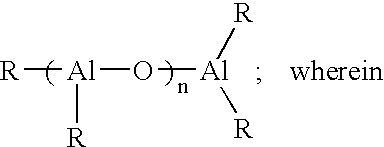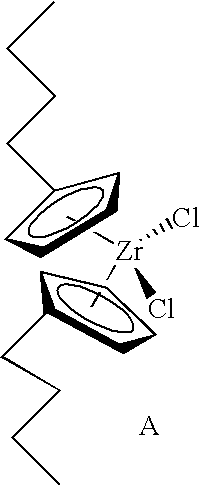Dual metallocene catalyst for producing film resins with good machine direction (MD) elmendorf tear strength
a metallocene catalyst and film resin technology, applied in the field of olefin polymerization catalysis, catalyst compositions, methods for polymerizing and copolymerizing olefins, polyolefins, etc., can solve the problems of significant challenges in the development of catalysts, and achieve the effect of sufficient melt strength
- Summary
- Abstract
- Description
- Claims
- Application Information
AI Technical Summary
Benefits of technology
Problems solved by technology
Method used
Image
Examples
example 1
General Testing Procedures
[0304]Melt index (MI, g / 10 min) was determined in accordance with ASTM D1238 condition F at 190° C. with a 2,160 gram weight.
[0305]High load melt index (HLMI, g / 10 min) was determined in accordance with ASTM D1238 condition E at 190° C. with a 21,600 gram weight.
[0306]Polymer density was determined in grams per cubic centimeter (g / cc) on a compression molded sample, cooled at about 15° C. per hour, and conditioned for about 40 hours at room temperature in accordance with ASTM D1505 and ASTM D1928, procedure C.
[0307]Molecular weights and molecular weight distributions were obtained using a Waters 150 CV gel permeation chromatograph with trichlorobenzene (TCB) as the solvent, with a flow rate of 1 milliliter / minute at a temperature of 140° C. 2,6-Di-t-butyl-4-methylphenol (BHT) at a concentration of 1.0 gram per liter was used as a stabilizer in the TCB. An injection volume of 220 liters was used with a nominal polymer concentration of 0.3 gram / liter at room ...
example 2
Preparation of a Fluorided Silica-Alumina Activator-Support
[0321]The silica-alumina used to prepare the fluorided silica-alumina acidic activator-support in this Example was obtained from W. R. Grace as Grade MS 13-110, containing 13% alumina, having a pore volume of about 1.2 cc / g and a surface area of about 400 m2 / g. This material was fluorided by impregnation to incipient wetness with a solution containing ammonium bifluoride in an amount sufficient to equal 10 wt % of the weight of the silica-alumina. This impregnated material was then dried in a vacuum oven for 8 hours at 100° C. The fluorided silica-alumina samples obtained in this manner were then calcined as follows. About 10 grams of the alumina were placed in a 1.75-inch quartz tube fitted with a sintered quartz disk at the bottom. While the silica was supported on the disk, dry air was blown up through the disk at the linear rate of about 1.6 to 1.8 standard cubic feet per hour. An electric furnace around the quartz tube ...
example 3
General and Specific Preparations of the Metallocenes
General Methods
[0322]General preparative methods for forming the first metallocene compounds and the second metallocene compounds can be found in a various references, including: U.S. Pat. Nos. 4,939,217; 5,191,132; 5,210,352; 5,347,026; 5,399,636; 5,401,817; 5,420,320; 5,436,305; 5,451,649; 5,496,781; 5,498,581; 5,541,272; 5,554,795; 5,563,284; 5,565,592; 5,571,880; 5,594,078; 5,631,203; 5,631,335; 5,654,454; 5,668,230; 5,705,579; 6,509,427; 5,705,579; and 6,509,427; and in Köppl, A. Alt, H. G. J. Mol. Catal A. 2001, 165, 23–32; Kajigaeshi, S.; Kadowaki, T.; Nishida, A.; Fujisaki, S. The Chemical Society of Japan, 1986, 59, 97; Alt, H. G.; Jung, M.; Kehr, G. J. Organomet. Chem. 1998, 562, 153–181; Alt, H. G.; Jung, M. J. Organomet. Chem. 1998, 568, 87–112; Journal of Organometallic Chemistry, 1996, 522, 39–54; and Wailes, P. C.; Coutts, R. S. P.; Weigold, H. in Organometallic Chemistry of Titanium, Zironium, and Hafnium, Academic...
PUM
 Login to View More
Login to View More Abstract
Description
Claims
Application Information
 Login to View More
Login to View More - R&D
- Intellectual Property
- Life Sciences
- Materials
- Tech Scout
- Unparalleled Data Quality
- Higher Quality Content
- 60% Fewer Hallucinations
Browse by: Latest US Patents, China's latest patents, Technical Efficacy Thesaurus, Application Domain, Technology Topic, Popular Technical Reports.
© 2025 PatSnap. All rights reserved.Legal|Privacy policy|Modern Slavery Act Transparency Statement|Sitemap|About US| Contact US: help@patsnap.com



